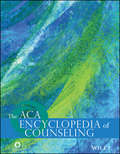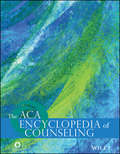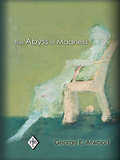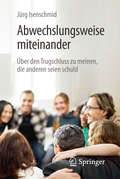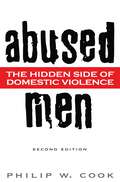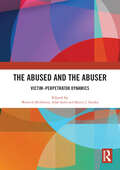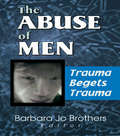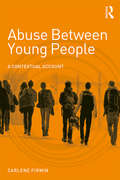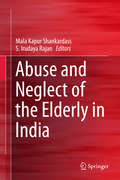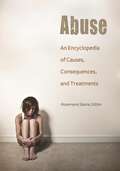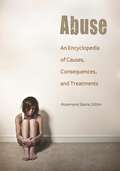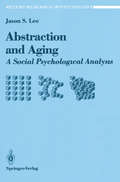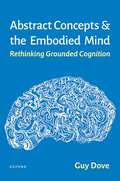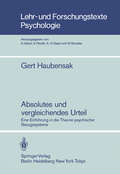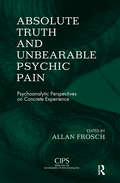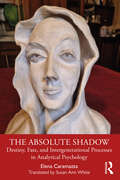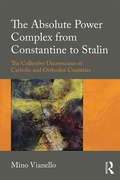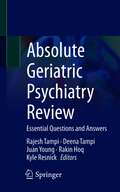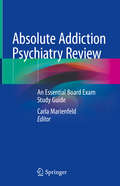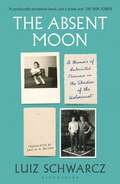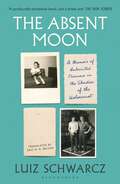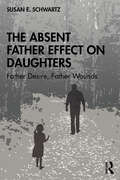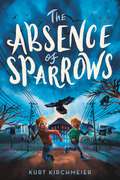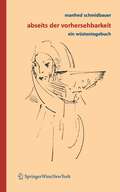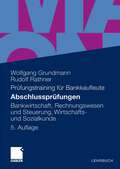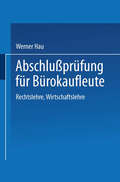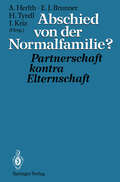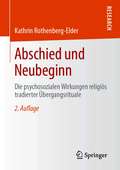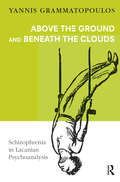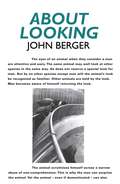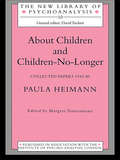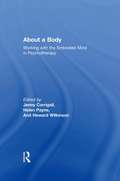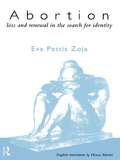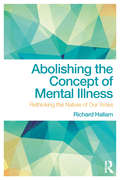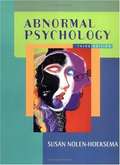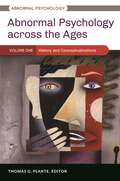- Table View
- List View
The ACA Encyclopedia of Counseling
by American Counseling AssociationThis premiere counseling reference book is ideal for students, educators, supervisors, researchers, and practitioners seeking to quickly update or refresh their knowledge of the most important topics in counseling. More than 400 entries span the 2009 CACREP core areas used in counselor preparation, continuing education, and accreditation of counseling degree programs, making this a perfect text for introductory counseling classes or for use as a study guide when preparing for the National Counselor Exam. This encyclopedia makes counseling come alive through its user-friendly writing style; instructive examples that connect readers to practice, teaching, supervision, and research; and its helpful cross-referencing of entries, boldfaced important terminology, and suggested resources for further study. *Requests for digital versions from the ACA can be found on wiley.com. *To request print copies, please visit the ACA website here: http://isgweb.counseling.org/ISGweb/Purchase/ProductDetail.aspx?Product_code=72879 *Reproduction requests for material from books published by ACA should be directed to permissions@counseling.org
The ACA Encyclopedia of Counseling
by American Counseling AssociationThis premiere counseling reference book is ideal for students, educators, supervisors, researchers, and practitioners seeking to quickly update or refresh their knowledge of the most important topics in counseling. More than 400 entries span the 2009 CACREP core areas used in counselor preparation, continuing education, and accreditation of counseling degree programs, making this a perfect text for introductory counseling classes or for use as a study guide when preparing for the National Counselor Exam. This encyclopedia makes counseling come alive through its user-friendly writing style; instructive examples that connect readers to practice, teaching, supervision, and research; and its helpful cross-referencing of entries, boldfaced important terminology, and suggested resources for further study. *Requests for digital versions from the ACA can be found on wiley.com. *To request print copies, please visit the ACA website here: http://isgweb.counseling.org/ISGweb/Purchase/ProductDetail.aspx?Product_code=72879 *Reproduction requests for material from books published by ACA should be directed to permissions@counseling.org
The Abyss of Madness (Psychoanalytic Inquiry Book Series)
by George E. AtwoodDespite the many ways in which the so-called psychoses can become manifest, they are ultimately human events arising out of human contexts. As such, they can be understood in an intersubjective manner, removing the stigmatizing boundary between madness and sanity. Utilizing the post-Cartesian psychoanalytic approach of phenomenological contextualism, as well as almost 50 years of clinical experience, George Atwood presents detailed case studies depicting individuals in crisis and the successes and failures that occurred in their treatment. Topics range from depression to schizophrenia, bipolar disorder to dreams, dissociative states to suicidality. Throughout is an emphasis on the underlying essence of humanity demonstrated in even the most extreme cases of psychological and emotional disturbance, and both the surprising highs and tragic lows of the search for the inner truth of a life – that of the analyst as well as the patient.
The Abyss of Madness (Psychoanalytic Inquiry Book Series)
by George E. AtwoodDespite the many ways in which the so-called psychoses can become manifest, they are ultimately human events arising out of human contexts. As such, they can be understood in an intersubjective manner, removing the stigmatizing boundary between madness and sanity. Utilizing the post-Cartesian psychoanalytic approach of phenomenological contextualism, as well as almost 50 years of clinical experience, George Atwood presents detailed case studies depicting individuals in crisis and the successes and failures that occurred in their treatment. Topics range from depression to schizophrenia, bipolar disorder to dreams, dissociative states to suicidality. Throughout is an emphasis on the underlying essence of humanity demonstrated in even the most extreme cases of psychological and emotional disturbance, and both the surprising highs and tragic lows of the search for the inner truth of a life – that of the analyst as well as the patient.
Abwechslungsweise miteinander: Über den Trugschluss zu meinen, die anderen seien schuld
by Jürg IsenschmidJeder von uns ist Teil eines sozialen Netzwerks oder einer Hierarchie. Im Kreise der Familie sind wir es als Eltern oder Jugendliche, beruflich als Vorgesetzte oder Mitarbeitende. Im Alltag sind wir hierbei immer wieder mit Situationen konfrontiert, die zu Störungen oder Disharmonie führen. Natürlich können wir es uns einfach machen und meinen, die anderen seien schuld. Doch trifft dies tatsächlich zu? Jürg Isenschmid versteht es, unser Verhalten in sozialen Gefügen anschaulich zu analysieren und uns erkennen zu lassen, dass jeder dazu beitragen kann, ein friedliches Miteinander zu gestalten – auch Sie!
Abused Men: The Hidden Side of Domestic Violence
by Philip W. CookAn award-winning investigative journalist provides a disturbing new look at an underreported type of domestic violence—the abuse of men.The first edition of Philip W. Cook's book, Abused Men: The Hidden Side of Domestic Violence (Praeger, 1997), drew attention and praise nationwide from individuals and from media, ranging from CNN and Fox network's The O'Reilly Factor to scholarly publications such as The Journal of Marriage and Family. On the 10th anniversary of that groundbreaking book, Cook began revising and expanding his work. The result is this second edition—a disturbing look at a trend that continues to increase.The new edition of Abused Men: The Hidden Side of Domestic Violence offers up-to-date data on the prevalence of intimate partner violence against men, incorporating personal interviews and cases drawn from the media. It also includes updates on law, legislation, court activity, social responses, police activity, support groups, batterer programs, and crisis intervention programs. The final chapter contains a detailed and specific description of needed reforms in the current approach to intimate partner violence, whether the victims are male or female.
The Abused and the Abuser: Victim–Perpetrator Dynamics
by Martin J. Dorahy Warwick Middleton Adah SachsSevere abuse often occurs in settings where the grouping, whether based around a family or a community organisation or institution, outwardly appears to be very respectable. The nature of attachment dynamics allied with threat, discrediting, the manipulation of the victim's dissociative defences, long-term conditioning and the endless invoking of shame mean that sexual, physical and emotional abuse may, in some instances, be essentially unending. Even when separation from the long-term abuser is attempted, it may initially be extremely difficult to achieve, and there are some individuals who never achieve this parting. Even when the abuser is dead, the intrapsychic nature of the enduring attachment experienced by their victim remains complicated and difficult to resolve. This volume includes multiple perspectives from highly experienced clinicians, researchers and writers on the nature of the relationship between the abused and their abuser(s). No less than five of this international grouping of authors have been president of the International Society for the Study of Trauma and Dissociation, the world's oldest international trauma society. This book, which opens with a highly original clinical paper on 'weaponized sex' by Richard Kluft, one of the foremost pioneers of the modern dissociative disorders field, concludes with a gripping historical perspective written by Jeffrey Masson as he reengages with issues that first brought him to worldwide prominence in the 1980s. Between these two pieces, the contributors, all highly acclaimed for their clinical, theoretical or research work, present original, cutting edge work on this complex subject. This book was originally published as a double special issue of the Journal of Trauma and Dissociation.
The Abused and the Abuser: Victim–Perpetrator Dynamics
by Warwick Middleton Adah Sachs Martin J. DorahySevere abuse often occurs in settings where the grouping, whether based around a family or a community organisation or institution, outwardly appears to be very respectable. The nature of attachment dynamics allied with threat, discrediting, the manipulation of the victim's dissociative defences, long-term conditioning and the endless invoking of shame mean that sexual, physical and emotional abuse may, in some instances, be essentially unending. Even when separation from the long-term abuser is attempted, it may initially be extremely difficult to achieve, and there are some individuals who never achieve this parting. Even when the abuser is dead, the intrapsychic nature of the enduring attachment experienced by their victim remains complicated and difficult to resolve. This volume includes multiple perspectives from highly experienced clinicians, researchers and writers on the nature of the relationship between the abused and their abuser(s). No less than five of this international grouping of authors have been president of the International Society for the Study of Trauma and Dissociation, the world's oldest international trauma society. This book, which opens with a highly original clinical paper on 'weaponized sex' by Richard Kluft, one of the foremost pioneers of the modern dissociative disorders field, concludes with a gripping historical perspective written by Jeffrey Masson as he reengages with issues that first brought him to worldwide prominence in the 1980s. Between these two pieces, the contributors, all highly acclaimed for their clinical, theoretical or research work, present original, cutting edge work on this complex subject. This book was originally published as a double special issue of the Journal of Trauma and Dissociation.
The Abuse of Men: Trauma Begets Trauma
by Barbara Jo BrothersWhen men are abused, everybody suffers. This courageous book exposes a dark secret: Men are often victims of abuse. Although a great deal of attention has recently been paid to the victimization of women, the role of men as victims--not just perpetrators--has been neglected. The Abuse of Men reveals the impact of physical, sexual, and emotional trauma on the lives and relationships of men. This groundbreaking book shows how the negative effects of both basic training and combat may also cause lasting damage to men's self-esteem, ability to trust, personal boundaries, and ability to form healthy relationships. The Abuse of Men explores the prevalence of other kinds of violence and abuse toward men and boys, from child-battering to spousal abuse. It also discusses how the culture of violence and societal expectations of boys and men can help drive victims of abuse toward continuing the cycle of violence. The Abuse of Men discusses the sources of trauma, including: the quality and quantity of domestic violence committed by women against men the role of abusive fathers in raising sons who become abusers vicarious traumatization from living with partners whose uncontrolled PTSD makes them dangerously abusive hazing, military training, and other socially sanctioned male-on-male violence trauma contagion and transactional victimizingThe Abuse of Men also offers specific suggestions for therapists working with abused men and their partners, including an innovative step-by-step program for treating couples who have both been traumatized. By understanding how men and boys become victims and respond to trauma, you can help heal their pain and teach them to build positive, loving relationships.
The Abuse of Men: Trauma Begets Trauma
by Barbara Jo BrothersWhen men are abused, everybody suffers. This courageous book exposes a dark secret: Men are often victims of abuse. Although a great deal of attention has recently been paid to the victimization of women, the role of men as victims--not just perpetrators--has been neglected. The Abuse of Men reveals the impact of physical, sexual, and emotional trauma on the lives and relationships of men. This groundbreaking book shows how the negative effects of both basic training and combat may also cause lasting damage to men's self-esteem, ability to trust, personal boundaries, and ability to form healthy relationships. The Abuse of Men explores the prevalence of other kinds of violence and abuse toward men and boys, from child-battering to spousal abuse. It also discusses how the culture of violence and societal expectations of boys and men can help drive victims of abuse toward continuing the cycle of violence. The Abuse of Men discusses the sources of trauma, including: the quality and quantity of domestic violence committed by women against men the role of abusive fathers in raising sons who become abusers vicarious traumatization from living with partners whose uncontrolled PTSD makes them dangerously abusive hazing, military training, and other socially sanctioned male-on-male violence trauma contagion and transactional victimizingThe Abuse of Men also offers specific suggestions for therapists working with abused men and their partners, including an innovative step-by-step program for treating couples who have both been traumatized. By understanding how men and boys become victims and respond to trauma, you can help heal their pain and teach them to build positive, loving relationships.
Abuse Between Young People: A Contextual Account
by Carlene FirminAwareness of peer-on-peer abuse is on the rise and is a matter of increasing international concern. Abuse Between Young People: A Contextual Account is the first book to offer a contextualised narrative of peer-on-peer abuse that moves beyond recognising an association between environments and individual choice, and illustrates the ways in which such interplay occurs. Using both sociological and feminist perspectives, Firmin reshapes the way that peer-on-peer abuse is perceived and investigates the effect of gendered social context on the nature of abuse between young people. This text also uses an in-depth case study to explore associations between abusive incidents and young people’s homes, peer groups, schools and neighbourhoods, in addition to broader societal influences such as pornography and politics. National and international policies are woven into each chapter, along with insights from parenting programmes, the troubled families’ agenda, and bullying and community safety policies. Abuse Between Young People presents a clear insight into the various contexts that affect the nature of peer-on-peer abuse, providing a thorough analysis into the debates on this issue. In so doing, Firmin creates a vital contextual approach to safeguarding young people affected by this issue. It is invaluable reading for students and researchers in social work, education, criminology, sociology and psychology, as well as practitioners and policymakers concerned with the protection of young people.
Abuse Between Young People: A Contextual Account
by Carlene FirminAwareness of peer-on-peer abuse is on the rise and is a matter of increasing international concern. Abuse Between Young People: A Contextual Account is the first book to offer a contextualised narrative of peer-on-peer abuse that moves beyond recognising an association between environments and individual choice, and illustrates the ways in which such interplay occurs. Using both sociological and feminist perspectives, Firmin reshapes the way that peer-on-peer abuse is perceived and investigates the effect of gendered social context on the nature of abuse between young people. This text also uses an in-depth case study to explore associations between abusive incidents and young people’s homes, peer groups, schools and neighbourhoods, in addition to broader societal influences such as pornography and politics. National and international policies are woven into each chapter, along with insights from parenting programmes, the troubled families’ agenda, and bullying and community safety policies. Abuse Between Young People presents a clear insight into the various contexts that affect the nature of peer-on-peer abuse, providing a thorough analysis into the debates on this issue. In so doing, Firmin creates a vital contextual approach to safeguarding young people affected by this issue. It is invaluable reading for students and researchers in social work, education, criminology, sociology and psychology, as well as practitioners and policymakers concerned with the protection of young people.
Abuse and Neglect of the Elderly in India
by Mala Kapur Shankardass S. Irudaya RajanThis book highlights different aspects of the problem of elder abuse and neglect in India, and discusses its forms as well as means of prevention, intervention and management. It presents a framework for understanding the occurrence of elder abuse and neglect in India, placing the discussion within the global context. Elder abuse and neglect is a growing concern in South Asia, and this is the first comprehensive account of the topic from India. It uses data from different parts of India to describe the various dimensions of elder abuse and neglect among different population categories and sections in society. Covering rural and urban areas in different states, it discusses current perspectives on elder abuse and neglect at the household level, widows, HIV-affected populations, and those residing in institutions. This book comprises views from experts in the field and is of interest to researchers and academics from the social and behavioural sciences, policy makers, and NGOs.
Abuse: An Encyclopedia of Causes, Consequences, and Treatments
by AuThis timely volume shows how abuse impacts every segment of society—and how society is seeking effective ways to respond.Abuse, a key theme of health education curricula, is also a major issue faced by many segments of society. Intended for high school students as well as undergraduates and the general reader, this comprehensive encyclopedia explores abuse in all its forms—physical, sexual, emotional, and verbal—among a variety of age and demographic groups from children to the elderly to the disabled. It sheds light on causes and symptoms of abuse, examines lasting impacts, and suggests avenues for prevention and treatment.Specific topics of concern to a secondary school audience include bullying and cyberbullying; abuse of those in same-sex relationships; and sexual abuse through rape, date rape, incest, and sexting. Elder abuse, which has become of greater concern as our society ages, is covered, as are domestic abuse, child abuse, and abduction. Through up-to-date entries by expert contributors, readers will learn about the causes and results of specific types of abuse, as well as their legal and sociological dimensions. The title will also serve as a gateway to further study—and as a resource for readers seeking help.
Abuse: An Encyclopedia of Causes, Consequences, and Treatments
by Rosemarie SkaineThis timely volume shows how abuse impacts every segment of society—and how society is seeking effective ways to respond.Abuse, a key theme of health education curricula, is also a major issue faced by many segments of society. Intended for high school students as well as undergraduates and the general reader, this comprehensive encyclopedia explores abuse in all its forms—physical, sexual, emotional, and verbal—among a variety of age and demographic groups from children to the elderly to the disabled. It sheds light on causes and symptoms of abuse, examines lasting impacts, and suggests avenues for prevention and treatment.Specific topics of concern to a secondary school audience include bullying and cyberbullying; abuse of those in same-sex relationships; and sexual abuse through rape, date rape, incest, and sexting. Elder abuse, which has become of greater concern as our society ages, is covered, as are domestic abuse, child abuse, and abduction. Through up-to-date entries by expert contributors, readers will learn about the causes and results of specific types of abuse, as well as their legal and sociological dimensions. The title will also serve as a gateway to further study—and as a resource for readers seeking help.
Abstraction and Aging: A Social Psychological Analysis (Recent Research in Psychology)
by Jason S. LeeAbstraction is one facet of intellectual functioning. The study of abstraction allows extremely valuable insights into human intelligence. While this monograph indicates that the ability to think abstractly declines slightly with age, there are a number of variables determining abstract thinking and its relation to intelligence over the life-span. This monograph defines abstraction from all angles of thought, contrasting it with high-order thinking and stereotyped thinking; it discusses and evaluates tests of abstract thinking; and it presents new findings in sociological and psychological research on abstraction.
Abstract Concepts and the Embodied Mind: Rethinking Grounded Cognition
by Guy DoveOur thoughts depend on knowledge about objects, people, properties, and events. To think about where we left our keys, what we are going to make for dinner, when we last fed the dogs, and how we are going to survive our next visit with our family, we need to know something about locations, keys, cooking, dogs, survival, families, and so on. As researchers have sought to explain how our brains can store and access such general knowledge, a growing body of evidence suggests that many of our concepts are grounded in action, emotion, and perception systems. We appear to think about the world by means of the same mechanisms that we use to experience it. Yet, abstract concepts like 'democracy,' 'fermion,' 'piety,' 'truth,' and 'zero' represent a clear challenge to this idea. Given that they represent a uniquely human cognitive achievement, answering the question of how we acquire and use them is central to our ability to understand ourselves. In Abstract Concepts and the Embodied Mind, Guy Dove contends that abstract concepts are heterogeneous and pose three important challenges to embodied cognition. They force us to ask: How do we generalize beyond the specifics of our experience? How do we think about things that we do not experience directly? How do we adapt our thoughts to specific contexts and tasks? He further argues that a successful theory of grounding must embrace multimodal representations, hierarchical architecture, and linguistic scaffolding. Focusing on a topic that has generated a lot of recent interest, this book shows that abstract concepts are the product of an elastic mind.
Abstract Concepts and the Embodied Mind: Rethinking Grounded Cognition
by Guy DoveOur thoughts depend on knowledge about objects, people, properties, and events. To think about where we left our keys, what we are going to make for dinner, when we last fed the dogs, and how we are going to survive our next visit with our family, we need to know something about locations, keys, cooking, dogs, survival, families, and so on. As researchers have sought to explain how our brains can store and access such general knowledge, a growing body of evidence suggests that many of our concepts are grounded in action, emotion, and perception systems. We appear to think about the world by means of the same mechanisms that we use to experience it. Yet, abstract concepts like 'democracy,' 'fermion,' 'piety,' 'truth,' and 'zero' represent a clear challenge to this idea. Given that they represent a uniquely human cognitive achievement, answering the question of how we acquire and use them is central to our ability to understand ourselves. In Abstract Concepts and the Embodied Mind, Guy Dove contends that abstract concepts are heterogeneous and pose three important challenges to embodied cognition. They force us to ask: How do we generalize beyond the specifics of our experience? How do we think about things that we do not experience directly? How do we adapt our thoughts to specific contexts and tasks? He further argues that a successful theory of grounding must embrace multimodal representations, hierarchical architecture, and linguistic scaffolding. Focusing on a topic that has generated a lot of recent interest, this book shows that abstract concepts are the product of an elastic mind.
Absolutes und vergleichendes Urteil: Eine Einführung in die Theorie psychischer Bezugssysteme (Lehr- und Forschungstexte Psychologie #12)
by Gert HaubensakAbsolute Truth and Unbearable Psychic Pain: Psychoanalytic Perspectives on Concrete Experience (CIPS (Confederation of Independent Psychoanalytic Societies) Boundaries of Psychoanalysis)
by Allan FroschThis book offers a wealth of original contributions, all promising steps towards a fuller understanding of the phenomenon of "concreteness" and towards more effective approaches to the clinical challenges concreteness poses.
Absolute Truth and Unbearable Psychic Pain: Psychoanalytic Perspectives on Concrete Experience (CIPS (Confederation of Independent Psychoanalytic Societies) Boundaries of Psychoanalysis)
by Allan FroschThis book offers a wealth of original contributions, all promising steps towards a fuller understanding of the phenomenon of "concreteness" and towards more effective approaches to the clinical challenges concreteness poses.
The Absolute Shadow: Destiny, Fate, and Intergenerational Processes in Analytical Psychology
by Elena CaramazzaThis book explores Jung’s central concept of shadow from a particular configuration that the author calls "Absolute Shadow," placing it in relation to the idea of destiny as catastrophic. Clinically based and supported by a vast number of therapy cases, the book exemplifies how the Absolute Shadow is a result of the projection of the most fragile and destructive parts of one’s psyche. In some cases, it may cause loss of identity and, through the mechanisms of false/double personality, is bound to result in psychosis. Other aspects of the Shadow, like the intergenerational shadow, are also examined in depth. The Absolute Shadow is the well-informed result of Caramazza’s fifty years of study and clinical experience. It is important reading for Jungian and depth psychologists, as well as for psychoanalytic students, trainees, and clinicians of all schools of thought.
The Absolute Shadow: Destiny, Fate, and Intergenerational Processes in Analytical Psychology
by Elena CaramazzaThis book explores Jung’s central concept of shadow from a particular configuration that the author calls "Absolute Shadow," placing it in relation to the idea of destiny as catastrophic. Clinically based and supported by a vast number of therapy cases, the book exemplifies how the Absolute Shadow is a result of the projection of the most fragile and destructive parts of one’s psyche. In some cases, it may cause loss of identity and, through the mechanisms of false/double personality, is bound to result in psychosis. Other aspects of the Shadow, like the intergenerational shadow, are also examined in depth. The Absolute Shadow is the well-informed result of Caramazza’s fifty years of study and clinical experience. It is important reading for Jungian and depth psychologists, as well as for psychoanalytic students, trainees, and clinicians of all schools of thought.
The Absolute Power Complex from Constantine to Stalin: The Collective Unconscious of Catholic and Orthodox Countries
by Mino VianelloIn The Absolute Power Complex from Constantine to Stalin: The Collective Unconscious of Catholic and Orthodox Countries Mino Vianello advances a new hermeneutical paradigm in analyzing why liberal-democratic institutions and ways of life do not flourish in Catholic and Orthodox countries. Vianello maintains that the breaking point is not the Reform, as Weber stated in the wake of de Tocqueville, but the events of the fourth century, with the Nicene Council, convoked by Constantine for the purely political purpose of giving a psychological cement to the crumbling empire, and Theodosius the Great’s decision to proclaim the Trinitarian Doctrine State Religion. These events left an indelible mark in the collective unconscious of the peoples who happened to fall into this mesh studded with neo-platonic philosophical categories and legal concepts derived from Roman Law. This book demonstrates the inception and effects of the Absolute Power Complex by linking the theological-political construction of the Church to later absolute regimes and twentieth century dictatorships. This distinguishes these countries from those Christianized by Arius’ followers, which eleven centuries later became Protestant. Vianello traces the wavering succession of philosophical and theological doctrines which have shaken Christianity, leading to a combination of politics and theology unknown to early Christians and the Evangelical Message. This is the first time that Jung’s concept of the Collective Unconscious has been historically explored in terms of political and social consequences in such an innovative and interdisciplinary way. Although Vianello explores historical themes, this book will be a fascinating resource for analytical psychologists and other professionals informed by Jung’s ideas. It will also appeal to academics and students of the history of ideas, political theory, sociology, hermeneutics, cultural studies and other professionals interested in contemporary events.
The Absolute Power Complex from Constantine to Stalin: The Collective Unconscious of Catholic and Orthodox Countries
by Mino VianelloIn The Absolute Power Complex from Constantine to Stalin: The Collective Unconscious of Catholic and Orthodox Countries Mino Vianello advances a new hermeneutical paradigm in analyzing why liberal-democratic institutions and ways of life do not flourish in Catholic and Orthodox countries. Vianello maintains that the breaking point is not the Reform, as Weber stated in the wake of de Tocqueville, but the events of the fourth century, with the Nicene Council, convoked by Constantine for the purely political purpose of giving a psychological cement to the crumbling empire, and Theodosius the Great’s decision to proclaim the Trinitarian Doctrine State Religion. These events left an indelible mark in the collective unconscious of the peoples who happened to fall into this mesh studded with neo-platonic philosophical categories and legal concepts derived from Roman Law. This book demonstrates the inception and effects of the Absolute Power Complex by linking the theological-political construction of the Church to later absolute regimes and twentieth century dictatorships. This distinguishes these countries from those Christianized by Arius’ followers, which eleven centuries later became Protestant. Vianello traces the wavering succession of philosophical and theological doctrines which have shaken Christianity, leading to a combination of politics and theology unknown to early Christians and the Evangelical Message. This is the first time that Jung’s concept of the Collective Unconscious has been historically explored in terms of political and social consequences in such an innovative and interdisciplinary way. Although Vianello explores historical themes, this book will be a fascinating resource for analytical psychologists and other professionals informed by Jung’s ideas. It will also appeal to academics and students of the history of ideas, political theory, sociology, hermeneutics, cultural studies and other professionals interested in contemporary events.
Absolute Geriatric Psychiatry Review: Essential Questions and Answers
by Rajesh Tampi Deena Tampi Juan Young Rakin Hoq Kyle ResnickThis book provides a comprehensive yet concise review of geriatric psychiatry in preparation for the board exam, or for reference during practice. Written by experts in the field, this text thoroughly reviews over 500 developmental, biological, diagnostic, and treatment questions for board certification. Unlike any other text on the market, this book takes a broader approach to the subject, making it accessible for physicians as well as other clinicians, including nurses, therapists, and social workers. Absolute Geriatric Psychiatry Review is an excellent resource for all clinicians who will care for the mental health of aging patients, including psychiatrists, neurologists, psychologists, therapists, nurses, social workers, nursing home administrators, and all others.
Absolute Addiction Psychiatry Review: An Essential Board Exam Study Guide
by Carla MarienfeldThis book serves as a tool for general psychiatrists, medical students, residents, and fellows looking for a clinically relevant and high-yield overview of addiction psychiatry in preparation for their board exams – or for everyday clinical practice. Written by expert educators in addiction psychiatry, the text is organized by substances misused and populations affected. This book serves as both a primary learning tool for those new to the field, as well as a reference for those working in addiction treatment. Each chapter begins with summaries of high yield clinical pearls, followed by general information including treatment, and then ends with accompanying board-style review questions. The scope includes understanding substances of misuse and substance use disorders (SUDs), how to evaluate, diagnose, and monitor SUDs, how to treat SUDs both pharmacologically and behaviorally, and critical information for specific populations of patients. Absolute Addiction Psychiatry for Clinical Practice and Review is an excellent resource for all medical students, residents, fellows, and professionals taking certification exams in addiction, including those in psychiatry, addiction medicine, emergency medicine, internal medicine, pain medicine, and others. The chapter "Laboratory Testing for Substance Use Disorders" is available open access under a Creative Commons Attribution 4.0 International License via link.springer.com.
The Absent Moon: A Memoir of a Short Childhood and a Long Depression
by Luiz Schwarcz'A beautiful work that is in turn haunting, touching and redemptive' SIMON SEBAG MONTEFIORE'A profoundly emotional book, and a brave one' THE NEW YORKER'Generous in spirit, devoid of self-pity, and an authentic literary achievement' ANDREW SOLOMON ------When Luiz Schwarcz was a child, he was told little about his grandfather Láios, a Hungarian Jew. Only later would he learn that Láios had ordered his son, Luiz's father, to leap from a train taking them to a Nazi death camp, while Láios himself was carried on to his death.What Luiz did know was that his father's melancholia haunted the house he grew up in. As many children of trauma do, Luiz assumed responsibility for his parents' happiness, and for a time blossomed into the family prodigy. But then, at a high point of outward success, he was brought low by a devastating mental breakdown.This astonishing memoir interrogates a personal story of mental health through a family history of murder, dispossession, silence and the long echo of the Holocaust across generations – animated by the love and compassion of a master storyteller.-----'Brave, honest, devastating, and hopeful ... Schwarcz is a masterful storyteller' ARIANA NEUMANN'A lyrical and intimate portrait of the author's lifelong, harrowing battle with depression' ABRAHAM VERGHESE
The Absent Moon: A Memoir of a Short Childhood and a Long Depression
by Luiz Schwarcz'A beautiful work that is in turn haunting, touching and redemptive' SIMON SEBAG MONTEFIORE'A profoundly emotional book, and a brave one' THE NEW YORKER'Generous in spirit, devoid of self-pity, and an authentic literary achievement' ANDREW SOLOMON ------When Luiz Schwarcz was a child, he was told little about his grandfather Láios, a Hungarian Jew. Only later would he learn that Láios had ordered his son, Luiz's father, to leap from a train taking them to a Nazi death camp, while Láios himself was carried on to his death.What Luiz did know was that his father's melancholia haunted the house he grew up in. As many children of trauma do, Luiz assumed responsibility for his parents' happiness, and for a time blossomed into the family prodigy. But then, at a high point of outward success, he was brought low by a devastating mental breakdown.This astonishing memoir interrogates a personal story of mental health through a family history of murder, dispossession, silence and the long echo of the Holocaust across generations – animated by the love and compassion of a master storyteller.-----'Brave, honest, devastating, and hopeful ... Schwarcz is a masterful storyteller' ARIANA NEUMANN'A lyrical and intimate portrait of the author's lifelong, harrowing battle with depression' ABRAHAM VERGHESE
The Absent Father Effect on Daughters: Father Desire, Father Wounds
by Susan E. SchwartzThe Absent Father Effect on Daughters investigates the impact of absent – physically or emotionally – and inadequate fathers on the lives and psyches of their daughters through the perspective of Jungian analytical psychology. This book tells the stories of daughters who describe the insecurity of self, the splintering and disintegration of the personality, and the silencing of voice. Issues of fathers and daughters reach to the intra-psychic depths and archetypal roots, to issues of self and culture, both personal and collective. Susan E. Schwartz illustrates the maladies and disappointments of daughters who lack a father figure and incorporates clinical examples describing how daughters can break out of idealizations, betrayals, abandonments and losses to move towards repair and renewal. The book takes an interdisciplinary approach, expanding and elucidating Jungian concepts through dreams, personal stories, fairy tales and the poetry of Sylvia Plath, along with psychoanalytic theory, including Andre Green’s ‘dead father effect’ and Julia Kristeva’s theories on women and the body as abject. Examining daughters both personally and collectively affected by the lack of a father, The Absent Father Effect on Daughters is highly relevant for those wanting to understand the complex dynamics of daughters and fathers to become their authentic selves. It will be essential reading for anyone seeking understanding, analytical and depth psychologists, other therapy professionals, academics and students with Jungian and post-Jungian interests.
The Absent Father Effect on Daughters: Father Desire, Father Wounds
by Susan E. SchwartzThe Absent Father Effect on Daughters investigates the impact of absent – physically or emotionally – and inadequate fathers on the lives and psyches of their daughters through the perspective of Jungian analytical psychology. This book tells the stories of daughters who describe the insecurity of self, the splintering and disintegration of the personality, and the silencing of voice. Issues of fathers and daughters reach to the intra-psychic depths and archetypal roots, to issues of self and culture, both personal and collective. Susan E. Schwartz illustrates the maladies and disappointments of daughters who lack a father figure and incorporates clinical examples describing how daughters can break out of idealizations, betrayals, abandonments and losses to move towards repair and renewal. The book takes an interdisciplinary approach, expanding and elucidating Jungian concepts through dreams, personal stories, fairy tales and the poetry of Sylvia Plath, along with psychoanalytic theory, including Andre Green’s ‘dead father effect’ and Julia Kristeva’s theories on women and the body as abject. Examining daughters both personally and collectively affected by the lack of a father, The Absent Father Effect on Daughters is highly relevant for those wanting to understand the complex dynamics of daughters and fathers to become their authentic selves. It will be essential reading for anyone seeking understanding, analytical and depth psychologists, other therapy professionals, academics and students with Jungian and post-Jungian interests.
The Absence of Sparrows: A Novel
by Kurt KirchmeierStranger Things meets The Stand in this haunting coming-of-age novel about a plague that brings the world to a halt -- and the boy who believes that his town's missing sparrows can save his family.In the small town of Griever's Mill, eleven-year-old Ben Cameron is expecting to finish off his summer of relaxing and bird-watching without a hitch. But everything goes wrong when dark clouds roll in.Old Man Crandall is the first to change -- human one minute and a glass statue the next. Soon it's happening across the world. Dark clouds fill the sky and, at random, people are turned into frozen versions of themselves. There's nowhere to run, nowhere to hide, and no one knows how to stop it.With his mom on the verge of a breakdown, and his brother intent on following the dubious plans put forth by a nameless voice on the radio, Ben must hold out hope that his town's missing sparrows will return with everyone's souls before the glass plague takes them away forever. p.p1 {margin: 0.0px 0.0px 0.0px 0.0px; font: 12.0px Helvetica; color: #454545}
Abseits der Vorhersehbarkeit: Ein Wüstentagebuch
by Manfred SchmidbauerKeiner, der in die Wüste geht, ist der Gleiche, wenn er wiederkommt. Ebenso wahr ist, dass die Wüste jene Fragen spiegelt, die uns bewegen, wenn wir sie betreten. Überwiegend zu Fuß, ohne Kamera, mit Zeichenstift und Tagebuch drang M. Schmidbauer, Autor von "gitterloser Käfig", "kreatives Netzwerk" und "Nerventurm" in die Wüste vor. Vor der Kulisse der Expeditionen in Marokko, Ägypten und der Republik Niger entwickeln sich Bilder von Aufbruch, Illusion und Neubeginn. Schritt für Schritt entsteht aus Tagebuchskizzen eine Landschaft psychologischer Metaphern. Knappe Texte und eindrucksvolle Zeichnungen aus der Welt menschlicher Empfindungen.
Abschlussprüfungen: Bankwirtschaft, Rechnungswesen und Steuerung, Wirtschafts- und Sozialkunde
by Wolfgang Grundmann Rudolf RathnerDie 5., überarbeitete Auflage ist auf den neuesten Rechtsstand gebracht. Es wurden alle für Sie wichtigen neuen Gesetze, Verordnungen und Vorschriften eingearbeitet. Darüber hinaus sind die Prüfungssätze den Anforderungen des aktuellen IHK-Prüfungskatalogs angepasst worden. Zum Buch gibt es einen kostenlosen Online-Aktualisierungsservice.
Abschied von der Normalfamilie?: Partnerschaft kontra Elternschaft
by Alois Herlth Ewald J. Brunner Hartmann Tyrell Jürgen KrizAbschied und Neubeginn: Die psychosozialen Wirkungen religiös tradierter Übergangsrituale
by Kathrin Rothenberg-ElderDas Leben ist voller Übergänge. Diese Übergänge müssen in irgendeiner Form angegangen, gestaltet, verarbeitet und in unser Leben integriert werden. Unabhängig vom Glauben an einen Gott geraten dabei immer wieder tradierte Strukturen in den Blick, hier besonders religiös tradierte Schwellenrituale wie Taufe und Beschneidung, Kommunion und Bar Mitzwah, Hochzeit wie Genesungs-, Sterbe- und Beerdigungsrituale. Welche psychologische Funktion haben dabei religiös tradierte Schwellenrituale heute? Dieser Frage wird mithilfe interaktiver Interviews von Funktionsträgern wie Mitgliedern der Religionsgemeinschaften aller drei monotheistischen Strömungen in Nordeuropa nachgegangen, flankiert von zwei Interviews mit Atheisten.
Above the Ground and Beneath the Clouds: Schizophrenia in Lacanian Psychoanalysis
by Yannis GrammatopoulosAbove the Ground and Beneath the Clouds examines the history, conceptualisation, and treatment of the psychotic sub-type of schizophrenia, as this is advocated by psychoanalysis of Lacanian orientation, which is contrasted to modern psychiatry. The book's main focus is the status of the schizophrenic body and language. The ways in which these concepts can be of theoretical and clinical use in contemporary clinical settings are examined throughout. The book consists of three parts. The first part comprises the theoretical investigation of schizophrenia in early 20th century psychiatry and in the theory and teaching of Freud, Lacan, and other influential psychoanalysts. The second part presents the fascinating case of the late 19th century Greek writer Georgios Vizyenos, who invented an extraordinary way to anchor the body before his admission to a psychiatric institution in 1896. The third part discusses the implications of those findings for the contemporary psychoanalytic diagnosis and treatment of schizophrenia. Assisted by examples from the author's clinical experience and from literature and art, this book sheds invaluable light on probably the most obscure sub-type of psychosis.
Above the Ground and Beneath the Clouds: Schizophrenia in Lacanian Psychoanalysis
by Yannis GrammatopoulosAbove the Ground and Beneath the Clouds examines the history, conceptualisation, and treatment of the psychotic sub-type of schizophrenia, as this is advocated by psychoanalysis of Lacanian orientation, which is contrasted to modern psychiatry. The book's main focus is the status of the schizophrenic body and language. The ways in which these concepts can be of theoretical and clinical use in contemporary clinical settings are examined throughout. The book consists of three parts. The first part comprises the theoretical investigation of schizophrenia in early 20th century psychiatry and in the theory and teaching of Freud, Lacan, and other influential psychoanalysts. The second part presents the fascinating case of the late 19th century Greek writer Georgios Vizyenos, who invented an extraordinary way to anchor the body before his admission to a psychiatric institution in 1896. The third part discusses the implications of those findings for the contemporary psychoanalytic diagnosis and treatment of schizophrenia. Assisted by examples from the author's clinical experience and from literature and art, this book sheds invaluable light on probably the most obscure sub-type of psychosis.
About Looking (Vintage International Series)
by John BergerAs a novelist, essayist, and cultural historian, John Berger is a writer of dazzling eloquence and arresting insight whose work amounts to a subtle, powerful critique of the canons of our civilization. In About Looking he explores our role as observers to reveal new layers of meaning in what we see. How do the animals we look at in zoos remind us of a relationship between man and beast all but lost in the twentieth century? What is it about looking at war photographs that doubles their already potent violence? How do the nudes of Rodin betray the threats to his authority and potency posed by clay and flesh? And how does solitude inform the art of Giacometti? In asking these and other questions, Berger alters the vision of anyone who reads his work.
About Children and Children-No-Longer: Collected Papers 1942-80 (The New Library of Psychoanalysis #Vol. 10)
by Paula HeimannAbout Children and Children-no-longer is the long awaited collection of Paula Heimann's published and unpublished papers. From the published work it includes the seminal paper 'On Countertransference' (1950); 'Dynamics and Transference Interpretations' (1956); 'Some Notes on Sublimation' (1959); and 'Notes on the Anal Stage' (1962). In addition, more recent works are published here in English for the first time, describing the author's particular integration of theory and technique. Paula Heimann's ideas on an undifferentiated early phase of infant development and its implications for analytic technique, along with her unique knowledge of both Kleinian object relations and classical theory and technique, make her work very relevant both to present-day practice and the understanding of the historical development of some central psychoanalytic ideas.
About Children and Children-No-Longer: Collected Papers 1942-80 (The New Library of Psychoanalysis)
by Paula HeimannAbout Children and Children-no-longer is the long awaited collection of Paula Heimann's published and unpublished papers. From the published work it includes the seminal paper 'On Countertransference' (1950); 'Dynamics and Transference Interpretations' (1956); 'Some Notes on Sublimation' (1959); and 'Notes on the Anal Stage' (1962). In addition, more recent works are published here in English for the first time, describing the author's particular integration of theory and technique. Paula Heimann's ideas on an undifferentiated early phase of infant development and its implications for analytic technique, along with her unique knowledge of both Kleinian object relations and classical theory and technique, make her work very relevant both to present-day practice and the understanding of the historical development of some central psychoanalytic ideas.
About a Body: Working with the Embodied Mind in Psychotherapy
by Jenny Corrigall Helen Payne Heward WilkinsonHow does our body reveal us to ourselves? The body can inform the work we do in mental health. This unique collection invites the reader to consider the way we think about the embodied mind, and how it can inform both our lives and our work in psychotherapy and counselling. The body is viewed as integral to the mind in this book, and in the approaches illustrated in it. Instead of splitting off the body and treating the patient as a body with a mind, contributors from a variety of approaches ask the reader to consider how we might be with, and work with, ‘bodymind’ as an interrelated whole. Subjects covered include: the application of affective neuroscience understandings to life as well as to clinical issues the body in psychotherapy with a person who is facing death the history, significance and scope of body psychotherapy today psychoanalytic approaches to working with the embodied mind authentic movement groups in the development of wellbeing in our bodymindspirit the body and spirituality This book is unique in its pluralism: it includes a wide range of differing views of the importance of the body in psychotherapy, both in theory and in practice, and it relates these to the latest discussions in affective neuroscience. It will be invaluable for those working in, or studying, psychotherapy and counselling, and will also interest those working generally in the mental health field.
About a Body: Working with the Embodied Mind in Psychotherapy
by Jenny Corrigall Helen Payne Heward WilkinsonHow does our body reveal us to ourselves? The body can inform the work we do in mental health. This unique collection invites the reader to consider the way we think about the embodied mind, and how it can inform both our lives and our work in psychotherapy and counselling. The body is viewed as integral to the mind in this book, and in the approaches illustrated in it. Instead of splitting off the body and treating the patient as a body with a mind, contributors from a variety of approaches ask the reader to consider how we might be with, and work with, ‘bodymind’ as an interrelated whole. Subjects covered include: the application of affective neuroscience understandings to life as well as to clinical issues the body in psychotherapy with a person who is facing death the history, significance and scope of body psychotherapy today psychoanalytic approaches to working with the embodied mind authentic movement groups in the development of wellbeing in our bodymindspirit the body and spirituality This book is unique in its pluralism: it includes a wide range of differing views of the importance of the body in psychotherapy, both in theory and in practice, and it relates these to the latest discussions in affective neuroscience. It will be invaluable for those working in, or studying, psychotherapy and counselling, and will also interest those working generally in the mental health field.
Abortion: Loss and Renewal in the Search for Identity
by Eva Pattis ZojaThe debate on abortion has tended to avoid the psychological significance of an unwanted pregnancy, dominated istead by the strong emotions the subject excites. Eva Pattis Zoja examines the thoughts that surround a woman's decision to end a pregnancy, and presents the challenging thesis that voluntary abortion can often be a violent and unconscious act of self-realisation. Treating a theme which is central to our existence, the author makes no attempt to argue for or against, or to deny the painful nature of the subject which she tackles, but instead looks at the way in which a decision to abort can affect a woman's inner life.
Abortion: Loss and Renewal in the Search for Identity
by Eva Pattis ZojaThe debate on abortion has tended to avoid the psychological significance of an unwanted pregnancy, dominated istead by the strong emotions the subject excites. Eva Pattis Zoja examines the thoughts that surround a woman's decision to end a pregnancy, and presents the challenging thesis that voluntary abortion can often be a violent and unconscious act of self-realisation. Treating a theme which is central to our existence, the author makes no attempt to argue for or against, or to deny the painful nature of the subject which she tackles, but instead looks at the way in which a decision to abort can affect a woman's inner life.
Abolishing the Concept of Mental Illness: Rethinking the Nature of Our Woes
by Richard HallamIn Abolishing the Concept of Mental Illness: Rethinking the Nature of Our Woes, Richard Hallam takes aim at the very concept of mental illness, and explores new ways of thinking about and responding to psychological distress. Though the concept of mental illness has infiltrated everyday language, academic research, and public policy-making, there is very little evidence that woes are caused by somatic dysfunction. This timely book rebuts arguments put forward to defend the illness myth and traces historical sources of the mind/body debate. The author presents a balanced overview of the past utility and current disadvantages of employing a medical illness metaphor against the backdrop of current UK clinical practice. Insightful and easy to read, Abolishing the Concept of Mental Illness will appeal to all professionals and academics working in clinical psychology, as well as psychotherapists and other mental health practitioners.
Abolishing the Concept of Mental Illness: Rethinking the Nature of Our Woes
by Richard HallamIn Abolishing the Concept of Mental Illness: Rethinking the Nature of Our Woes, Richard Hallam takes aim at the very concept of mental illness, and explores new ways of thinking about and responding to psychological distress. Though the concept of mental illness has infiltrated everyday language, academic research, and public policy-making, there is very little evidence that woes are caused by somatic dysfunction. This timely book rebuts arguments put forward to defend the illness myth and traces historical sources of the mind/body debate. The author presents a balanced overview of the past utility and current disadvantages of employing a medical illness metaphor against the backdrop of current UK clinical practice. Insightful and easy to read, Abolishing the Concept of Mental Illness will appeal to all professionals and academics working in clinical psychology, as well as psychotherapists and other mental health practitioners.
Abnormal Psychology (PDF)
by Susan Nolen-HoeksemaAuthored by award-winning teacher and noted researcher Susan Nolen-Hoeksema, this text blends cutting-edge research in psychopathology with compassion for people who suffer from psychological disorders. Capturing the excitement of major advances in biological and psychosocial research and treatment alternatives, Abnormal Psychology imparts a true enthusiasm for and appreciation of scientific investigation. The author’s scientific and caring approach, combined with strong study tools, has won accolades from instructors and students alike. The fourth edition reflects greater emphasis on integrated approaches to abnormal psychology, a constant drive to make biological information clear to students, and a stronger focus on empirical research and
Abnormal Psychology across the Ages [3 volumes]: [3 volumes] (Abnormal Psychology)
by Thomas G. PlanteIn these three volumes, a team of scholars provides a thoughtful history of abnormal psychology, demonstrating how concepts regarding disordered mental states, their causes, and their treatments developed and evolved across the ages.Compiling current thought from some of the best minds in the field, Abnormal Psychology across the Ages provides essays that reflect on multiple dimensions of abnormal behavior. These experts present biological, psychological, social, cultural, and supernatural perspectives throughout human history on a range of disorders, as well as the global influences on scientific thinking. A fascinating read for anyone in the field of abnormal psychology, from undergraduate students to clinicians, counselors, psychologists, and psychiatrists, this three-volume work addresses questions such as: What is "abnormal" psychology and thinking? What are the causes, how have we treated it, and how do we treat it now? And how does the culture of the times affect what we perceive as "abnormality"?
